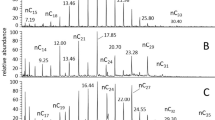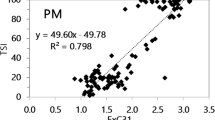Abstract
Acephenanthrylene and aceanthrylene in aromatic fraction of aerosols were identified by means of online hydrogenation gas chromatography mass spectrometry(GCMS). Compared aerosols from various sources, acephenanthrylene and aceanthrylene were ubiquitously present in urban aerosol. High concentration of acephenanthrylene and aceanthrylene were found in agricultural biomass and coal combustion particles. However, it is difficult to detect in exhaust from gasoline and diesel engine, dustfall, waste water, soil, and sediment. Combustion emissions were considered the major source of acephenanthrylene and aceanthrylene, which can be used as a potential molecular marker for the source pollution in urban aerosols.
Similar content being viewed by others
References
Oro J, Han J. High-Temperature Synthesis of Aromatic Hydrocarbons from Methane. Science, 1966, 153(3742): 1393–1395
Lee M L, and Hites R A. Characterization of sulfur-containing polycyclic aromatic compounds in carbon blacks. Anal Chem, 1976, 78(13): 1890–1893
Severson R F, Snook M E, Arrendale R F, et al. Gas chromatographic quantitation of polynuclear aromatic hydrocarbons in tobacco smoke. Anal Chem, 1976, 48(13): 1866–1872
Lee M L, Prado G P, Howard J B, et al. Source identification of urban airborne polycyclic aromatic hydrocarbons by gas chromatographic mass spectrometry and high resolution mass spectrometry. Biomed Mass Spectrom, 1977, 4(3): 182–185
Simoneit B R T, Rogge W F, Lang Q, et al. Molecular characterization of smoke from campfire burning of pine wood (Pinus elliottii). Chemosphere: Global Sci Change, 2000, 2(1): 107–122
Hays M D, Fine P M, Geron C D, et al. Open burning of agricultural biomass: Physical and chemical properties of particle-phase emissions. Atmos Environ, 2005. 39(36): 6747–6764
Wang Z, Li K, Lambert P, et al. Identification, characterization and quantitation of pyrogenic polycylic aromatic hydrocarbons and other organic compounds in tire fire products. J Chromatogr A, 2007, 1139(1): 14–26
Krishnan S, Hites R A. Identification of acephenanthrylene in combustion effluents. Anal Chem, 1981, 53(2): 342–343
Nesnow S, Beck S, Ball L M, et al. Morphological transformation of C3H10T1/2CL8 cells by cyclopenta-fused derivatives of benzo[a] pyrene and benzo[e]pyrene. Cancer Lett, 1993, 74(1–2): 25–30
Busby Jr W F, Smith H, Plummer E F, et al. Mutagenicity of cyclopenta-fused polynuclear aromatic hydrocarbons and a non-polar fraction from a fuel combustion sample in a Salmonella forward mutation assay without exogenous metabolic activation. Mutat Res-Gen Tox En, 1997, 391(3): 117–125
Otero-Lobato M J, Kaats-Richters V E M, Koper C, et al. CP-arene oxides: the ultimate, active mutagenic forms of cyclopenta-fused polycyclic aromatic hydrocarbons (CP-PAHs). Mutat Res-Gen Tox En, 2005, 581(1–2): 115–132
Howard J B, Longwell J P, Marr J A, et al. Effects of PAH isomerizations on mutagenicity of combustion products. Combust Flame, 1995, 101(3): 262–270
Sawicki E. Analysis for airborne particulate hydrons. Their relative proportion affected by different types of pollution. Nat Cancer Inst Monograph, 1962, 9: 201–208
Greenberg A, Bozzelli J W, Cannova F, et al. Correlation between lead and coroene at urban, suburban and industrial sites in New Jerrsey. Environ. Sci Technol, 1981, 17: 895–902
Cheng W, Sheng G Y, Fu J M, et al. Identification of 1,3,5-triphenylbenzene in aerosol of Pearl River Delta and its environmental implication. Chin Sci Bull (in Chinese), 1999, 42(7): 728–730
Simcik M F, Eisenreich S J, Lioy P J. Source apportionment and source/sink relationships of PAHs in the coastal atmosphere of Chicago and Lake Michigan. Atmos Environ, 1999, 33(30): 5071–5079
Zhou T. Characterization on sources composition of polyaromatic compounds on aerosol particle. Dissertation for the Master Degree (in Chinese), Beijing: China University of Petroleum, 2006. 11–12
Wornat M J, Vernaglia B A, Lafleur A L, et al. Cyclopenta-fused polycyclic aromatic hydrocarbons from brown coal pyrolysis. Proc Combust Inst, 1998, 27(2): 1677–1686
James C W. Polycyclic aromatic hydrocarbons in combustion residues from 1,3-butadiene. Chemosphere, 1998, 37(1): 143–157
Marsh N D, and Wornat M J. Formation pathways of ethynyl-substituted and cyclopenta-fused polycyclic aromatic hydrocarbons. Proc Combust Inst, 2000, 28(2): 2585–2592
Author information
Authors and Affiliations
Corresponding author
Additional information
Supported by the National Major Basic Research Program of China (Grand No. 20030425007)
About this article
Cite this article
Shi, Q., Wang, T., Zhong, N. et al. Identification of acephenanthrylene and aceanthrylene in aerosol and its environmental implication. Chin. Sci. Bull. 53, 890–894 (2008). https://doi.org/10.1007/s11434-008-0075-1
Received:
Accepted:
Published:
Issue Date:
DOI: https://doi.org/10.1007/s11434-008-0075-1




